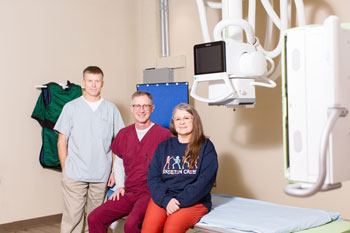Diagnostic Imaging Improves Rural Healthcare
Picture of five Diagnostic Imaging Staff members standing and sitting near an MRI machine.Advancements in rural healthcare is contributing to the surge in the country wide trend of people leaving big cities for smaller communities. The access of quality healthcare as well as connectivity to larger surrounding communities can make the difference to those considering a move to one community over another. Some rural hospitals are investing back into their facilities through technological advancements in many areas such as the diagnostic imaging they provide.
Diagnostic imaging is a tool that allows doctors to see inside the body to provide patients with a diagnosis and give peace of mind. This tool is used by doctors who need additional information about what is happening inside the body. For example: if the patient is experiencing abdominal pain, they might be sent for an ultrasound, or knee pain, may require an MRI. The type of diagnostic imaging needed for each patient is determined by their provider.
Fall River Health Services (FRHS) in Hot Springs, SD is equipped with the necessary diagnostic imaging to provide this critical service for the local community. This means patients in the area have more choices on where they can receive their care and may not have to travel. Ed Pellicotte, the radiology and imaging manager at FRHS explained not only is the equipment available to provide diagnostic imaging at their facility, but all imaging is read by Dakota Radiology within just a few hours. This allows patients access to fast results and a connecting resource. "If patients need to go to a larger town for a procedure, our connection with Dakota Radiology allows their doctor to see the diagnostic imaging taken at our facility," said Pellicotte.

It is common to hear of advancements in treatment options in the medical industry and the imaging side of the field is no different. Pellicotte explained some of the advancements in imaging used at FRHS, "We used to have a Siemens CT scanner that was a 16 slice, that was the speed it ran and how many slices were taken in a certain time frame. Now we have a machine that is a 128 slice. As a comparison, a lot of the areas of our size use a 64 slice."
Slices are the individual images taken by a CT scanner. The machine is acquiring images of your body from head to toe and uses these two-dimensional images to convert them into three-dimensional image for your doctor to read. With 128 slices, the process is much faster and of higher image quality. The added benefit for patients of FRHS is a decrease in the time needed to hold one's breath while scans are completed.
FRHS also recently purchased a state-of-the-art DEXA machine made by Hologic to keep up with the most advanced technology. The Hologic DEXA machine provides superior bone density scans. These types of scans are key in the detection of osteoporosis, a condition that an estimated 10 million Americans have and is characterized bones that are fragile and more prone to breaking. Pellicotte explained that this machine provides higher resolution images for better bone mapping and eliminates beam overlap errors found in older models.

Equipment is only one part of the equation when it comes to diagnostic imaging. The technicians and people behind the scenes are just as important in providing great images and a caring environment for patients. Pellicotte described the team at FRHS, "We have a veteran crew here. We have 4 technologists and each of our techs are registered. That means every image done here, is done by registered technologists."
Imaging is key for patients to get answers. It allows providers to see inside the body in a non- invasive way. Pellicotte explained, "We are disease finders. We can get the doctor and patient an answer." Diagnostic imaging is a crucial part in providing solutions, saving lives, and helping people.
For more information on what is provided by Fall River Health Services and to schedule an appointment call 605.745.8910 or visit their website at https://www.frhssd.org/





